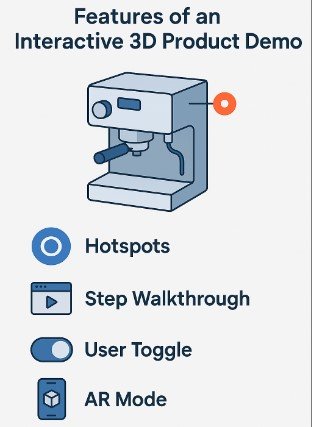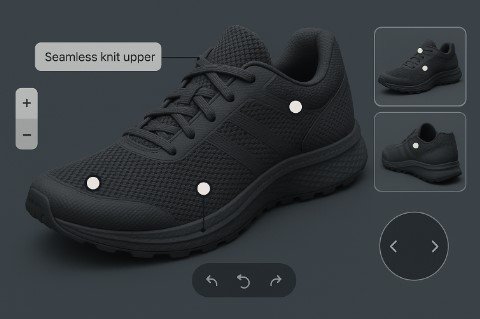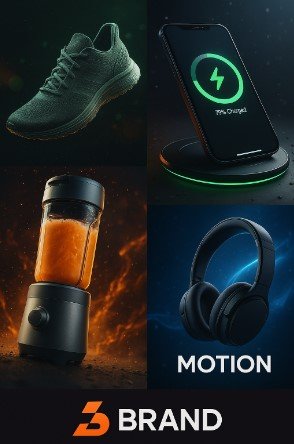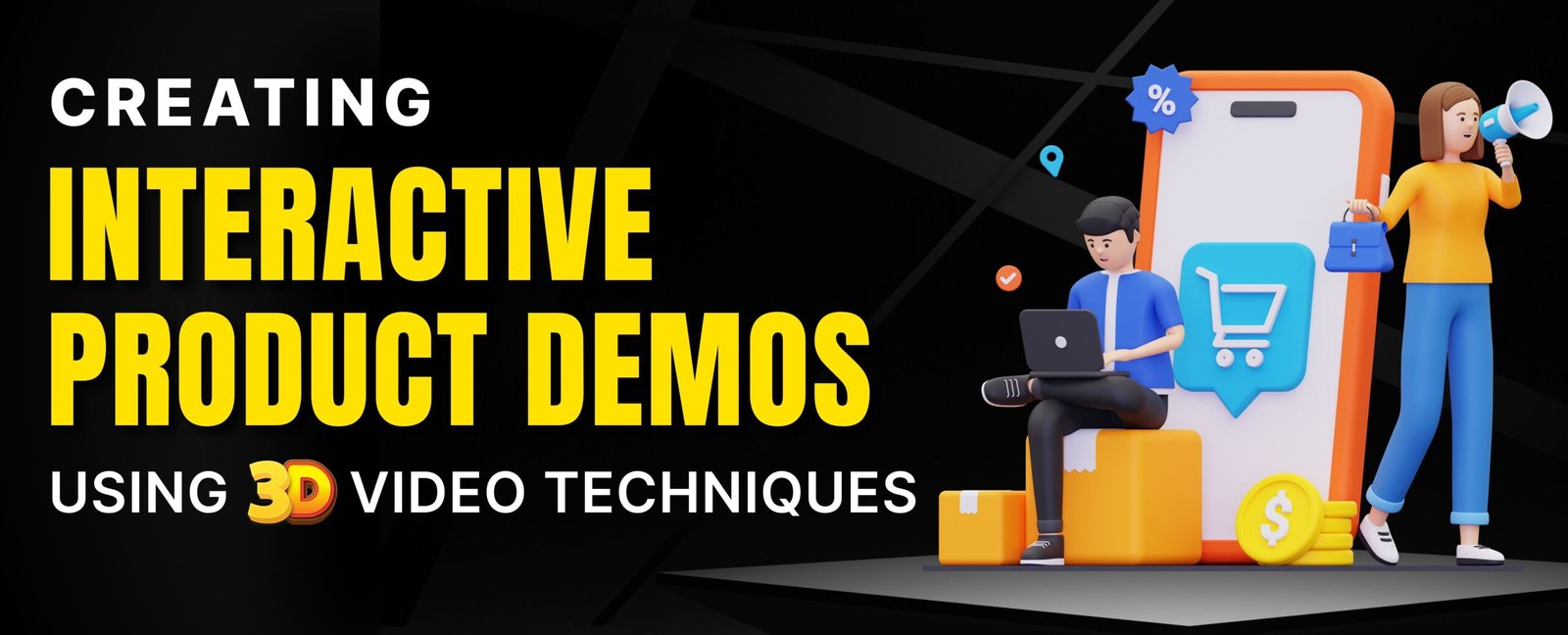Introduction
Showing how a product works should be simple. But too often, we rely on flat videos or static slides that just scratch the surface.
They tell people what a product does, but not how it feels to use it. And that’s a problem, because today’s users want more than just information.
They want to experience the product before making a decision. This is where 3D video techniques are making a real difference.
These demos let people interact with your product – rotate it, explore its features, and see it from every angle. It’s the closest thing to trying it in real life. From gadgets and devices to apps and platforms, businesses are now using 3D demos to simplify explanations and spark curiosity.
Whether it’s on a website, during a pitch, or inside an app, these videos help people truly get what you’re offering, quickly and clearly. Let’s walk through how it works and how your business can use it too.
What Are Interactive 3D Product Demos?
An interactive product demo built with 3D video techniques is more than a visual walkthrough. It gives users control to explore features, navigate views, and get a close look at every angle of a product. Think of a virtual showroom that responds to your audience’s curiosity.
These demos usually include:

- Digital twins or 3D models that reflect the real product
- Walkthroughs that highlight functionality through 3D animation video
- Hotspots for information overlays
- Interactive options like toggles, color selections, or feature configurations
- AR or VR views for immersive interaction
This format isn’t limited to physical products. Service providers in the banking industry use interactive walkthroughs to help users explore how digital wallets, dashboards, or platforms work.
Why Interactive 3D Product Demos Matter
Every demo is a sales conversation, without involving humans. This means the visuals must speak directly to the user’s intent.
Current-day users don’t just want to “see” the product, they want to understand how it works, how it solves a problem, and what sets it apart. That’s where 3D animation video becomes a functional communication bridge in modern product marketing.
These demos reduce sales pressure by allowing users to interact, explore, and evaluate at their own pace. Whether you’re introducing a SaaS dashboard or a mechanical tool, 3D walkthroughs offer something static pages or 2D animations don’t: depth and choice.
What Makes a 3D Product Demo Interactive
- The user can control the view — rotate, zoom, or enter different angles.
- Specific elements respond to actions — click, tap, or hover.
- The journey isn’t linear — users explore based on interest.
Combine this with stylized storytelling – lighting, angles, user control, hover states, and your audience is now engaging with your video. This approach often resembles what we see in VFX-driven 3D animated product ads – stories that mix technical clarity with style and surprise.

Why Businesses Are Using 3D Interactive Demos
Engaging Attention Where It Matters
Static content asks the viewer to follow. Interactive demos let them lead. This active involvement improves focus and makes it easier for viewers to absorb what they’re seeing.
The banking industry uses this strategy well. Instead of explaining investment products through PDFs, institutions use animated videos that allow customers to select risk levels and explore portfolio behaviors.
Helping Viewers Understand Faster
With 3D visuals, technical features are broken down into digestible movements, angles, and highlights. Whether it’s how a sound system manages frequencies or how a loan calculator behaves, interaction gives clarity.
In the banking industry, for example, customers often feel confused navigating new platforms. A video 3D animation demo that guides them step-by-step makes their learning curve smoother.
Shortening Decision Time
With interactive demos, users don’t need sales calls or long FAQs to decide. They try, explore, and get answers right inside the video. This approach has helped reduce sales cycles by several days across industries.
Make an Interactive 3D Product Demo
Brands that want to make animated videos that convert need to think beyond storytelling. It’s not just about showing what the product does – it’s about letting the user feel it firsthand. This approach turns passive viewers into active participants.
When you work with a team offering professional animation video production services, they won’t just create an animation. They’ll design a decision journey, one that improves product understanding, drives action, and supports long-term recall.

Whether you’re in SaaS, manufacturing, or the banking industry, interactive 3D demos are one of the clearest ways to demonstrate complexity without overwhelming the user.
Key Techniques Used by a Video Production Agency
A skilled video production agency uses the following tools and logic to build interactivity:
1. 3D Modeling & Texturing
Creating a realistic product replica in 3D using Blender, Cinema 4D, or Autodesk Maya. Materials are layered with texture maps to mimic real-world finishes like plastic, glass, metal, or rubber.
2. Animation Logic
Motion sequences are mapped to simulate user actions or device behavior – e.g., a screen lighting up when a switch is flipped or airflow being demonstrated inside a machine.
3. Interaction Triggers
Custom code (usually in JavaScript or Unity) enables viewer-driven motion. A user hovers or clicks, and a predefined event occurs – a breakdown of components, a voiceover starting, or a part animating.
4. Narrative Flow & Voiceover
Even in interactive demos, a storyline helps. A script paired with voiceover ensures users understand key features without feeling overwhelmed by options.
Where 3D Videos Are Working Well
Healthcare
Medical equipment brands use 3D video walkthroughs to train buyers or doctors on device usage and setup.
Automotive
Vehicle brands use video 3D animation to let users explore interiors, switch dashboard themes, run a simulated test drive or showcasing product demo.
Hestur Werewolf Scooter 3D Launch Video
Software & Banking Tools
Platforms offering digital tools often use interactive 3D product demos to reduce onboarding friction. It’s easier to explain investment workflows, dashboard navigation, or feature usage with visuals over text.
In these cases, consider 3D explainer videos as a good investment for your brand. Instead of bombarding prospects with long pitch decks or endless onboarding screens, animated demos walk them through each core module with a blend of narrative and interaction.
Drawing Inspiration From Top Video Ads

Some of the most impactful product videos include advanced VFX or cinematic sequences that leave a visual imprint. Even if your project doesn’t require full visual effects, studying these ads shows how motion, pacing, and voice can add clarity.
Measuring Success Beyond Views
Good demos don’t just look sharp, they guide decisions. Track user actions such as where they click, how long they engage, what they skip.
If most users exit before interacting with the second hotspot, your structure might need adjusting. When a user watches until the end and fills out a form, you know your story holds their attention.
FAQs
1. How to create a 3D video of a product?
Start by defining your goal and collecting product references. Then model the product in 3D software, add textures and lighting, animate key movements, and render the video. A video production agency can help polish and deliver the final output with professional voiceover, effects, and background score.
2. How to make a product video demo?
Begin by scripting the key features and user journey. Next, create visual assets, either live-action footage or 3D renders. Add voiceover, callouts, and transitions to keep viewers engaged. If you’re planning an interactive demo, integrate clickable elements or hotspots. Partnering with experts who make animated videos helps ensure visual clarity and usability.
3. What is a 3D product animation video?
A 3D product animation video is a visual demonstration that shows how a product looks and works using digital 3D models. It simulates movement, assembly, or usage without filming the real object. These videos are widely used in e-commerce, tech, and the banking industry for interactive demos, pitches, and explainer content.
5. How are 3D videos created?
3D videos are created through a structured process: concept development, 3D modeling, texturing, lighting, animation, and rendering. Motion paths are assigned to simulate product functionality or experience. These are often produced by a video production agency with expertise in video 3D animation and specialized software like Blender, Maya, or Cinema 4D.
Conclusion
Whether you work in electronics, healthcare, or the banking industry, interactive demos using 3D animation video help bridge the gap between product complexity and user clarity. The combination of smart storytelling, animation, and user-driven exploration makes these demos worth the investment.
If you’re planning to make animated videos that not only look good but also help viewers take action, then collaborating with an experienced video production agency makes all the difference.



